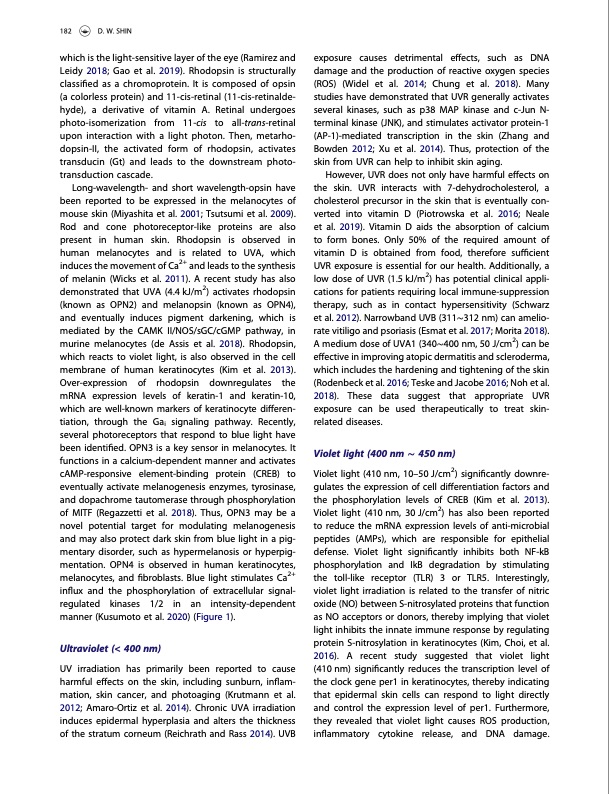
PDF Publication Title:
Text from PDF Page: 003
182 D. W. SHIN which is the light-sensitive layer of the eye (Ramirez and Leidy 2018; Gao et al. 2019). Rhodopsin is structurally classified as a chromoprotein. It is composed of opsin (a colorless protein) and 11-cis-retinal (11-cis-retinalde- hyde), a derivative of vitamin A. Retinal undergoes photo-isomerization from 11-cis to all-trans-retinal upon interaction with a light photon. Then, metarho- dopsin-II, the activated form of rhodopsin, activates transducin (Gt) and leads to the downstream photo- transduction cascade. Long-wavelength- and short wavelength-opsin have been reported to be expressed in the melanocytes of mouse skin (Miyashita et al. 2001; Tsutsumi et al. 2009). Rod and cone photoreceptor-like proteins are also present in human skin. Rhodopsin is observed in human melanocytes and is related to UVA, which induces the movement of Ca2+ and leads to the synthesis of melanin (Wicks et al. 2011). A recent study has also demonstrated that UVA (4.4 kJ/m2) activates rhodopsin (known as OPN2) and melanopsin (known as OPN4), and eventually induces pigment darkening, which is mediated by the CAMK II/NOS/sGC/cGMP pathway, in murine melanocytes (de Assis et al. 2018). Rhodopsin, which reacts to violet light, is also observed in the cell membrane of human keratinocytes (Kim et al. 2013). Over-expression of rhodopsin downregulates the mRNA expression levels of keratin-1 and keratin-10, which are well-known markers of keratinocyte differen- tiation, through the Gai signaling pathway. Recently, several photoreceptors that respond to blue light have been identified. OPN3 is a key sensor in melanocytes. It functions in a calcium-dependent manner and activates cAMP-responsive element-binding protein (CREB) to eventually activate melanogenesis enzymes, tyrosinase, and dopachrome tautomerase through phosphorylation of MITF (Regazzetti et al. 2018). Thus, OPN3 may be a novel potential target for modulating melanogenesis and may also protect dark skin from blue light in a pig- mentary disorder, such as hypermelanosis or hyperpig- mentation. OPN4 is observed in human keratinocytes, melanocytes, and fibroblasts. Blue light stimulates Ca2+ influx and the phosphorylation of extracellular signal- regulated kinases 1/2 in an intensity-dependent manner (Kusumoto et al. 2020) (Figure 1). Ultraviolet (< 400 nm) UV irradiation has primarily been reported to cause harmful effects on the skin, including sunburn, inflam- mation, skin cancer, and photoaging (Krutmann et al. 2012; Amaro-Ortiz et al. 2014). Chronic UVA irradiation induces epidermal hyperplasia and alters the thickness of the stratum corneum (Reichrath and Rass 2014). UVB exposure causes detrimental effects, such as DNA damage and the production of reactive oxygen species (ROS) (Widel et al. 2014; Chung et al. 2018). Many studies have demonstrated that UVR generally activates several kinases, such as p38 MAP kinase and c-Jun N- terminal kinase (JNK), and stimulates activator protein-1 (AP-1)-mediated transcription in the skin (Zhang and Bowden 2012; Xu et al. 2014). Thus, protection of the skin from UVR can help to inhibit skin aging. However, UVR does not only have harmful effects on the skin. UVR interacts with 7-dehydrocholesterol, a cholesterol precursor in the skin that is eventually con- verted into vitamin D (Piotrowska et al. 2016; Neale et al. 2019). Vitamin D aids the absorption of calcium to form bones. Only 50% of the required amount of vitamin D is obtained from food, therefore sufficient UVR exposure is essential for our health. Additionally, a low dose of UVR (1.5 kJ/m2) has potential clinical appli- cations for patients requiring local immune-suppression therapy, such as in contact hypersensitivity (Schwarz et al. 2012). Narrowband UVB (311∼312 nm) can amelio- rate vitiligo and psoriasis (Esmat et al. 2017; Morita 2018). A medium dose of UVA1 (340∼400 nm, 50 J/cm2) can be effective in improving atopic dermatitis and scleroderma, which includes the hardening and tightening of the skin (Rodenbeck et al. 2016; Teske and Jacobe 2016; Noh et al. 2018). These data suggest that appropriate UVR exposure can be used therapeutically to treat skin- related diseases. Violet light (400 nm ∼ 450 nm) Violet light (410 nm, 10–50 J/cm2) significantly downre- gulates the expression of cell differentiation factors and the phosphorylation levels of CREB (Kim et al. 2013). Violet light (410 nm, 30 J/cm2) has also been reported to reduce the mRNA expression levels of anti-microbial peptides (AMPs), which are responsible for epithelial defense. Violet light significantly inhibits both NF-kB phosphorylation and IkB degradation by stimulating the toll-like receptor (TLR) 3 or TLR5. Interestingly, violet light irradiation is related to the transfer of nitric oxide (NO) between S-nitrosylated proteins that function as NO acceptors or donors, thereby implying that violet light inhibits the innate immune response by regulating protein S-nitrosylation in keratinocytes (Kim, Choi, et al. 2016). A recent study suggested that violet light (410 nm) significantly reduces the transcription level of the clock gene per1 in keratinocytes, thereby indicating that epidermal skin cells can respond to light directly and control the expression level of per1. Furthermore, they revealed that violet light causes ROS production, inflammatory cytokine release, and DNA damage.PDF Image | Various biological effects of solar radiation on skin

PDF Search Title:
Various biological effects of solar radiation on skinOriginal File Name Searched:
biological-effects-solar-radiation-phototherapy.pdfDIY PDF Search: Google It | Yahoo | Bing
Cruise Ship Reviews | Luxury Resort | Jet | Yacht | and Travel Tech More Info
Cruising Review Topics and Articles More Info
Software based on Filemaker for the travel industry More Info
The Burgenstock Resort: Reviews on CruisingReview website... More Info
Resort Reviews: World Class resorts... More Info
The Riffelalp Resort: Reviews on CruisingReview website... More Info
| CONTACT TEL: 608-238-6001 Email: greg@cruisingreview.com | RSS | AMP |